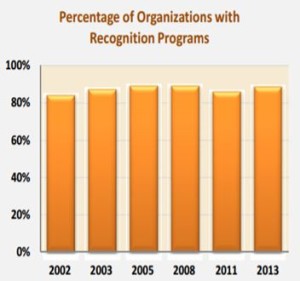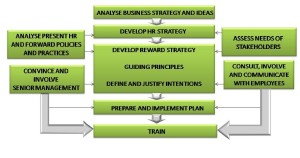How “Rewards and Recognition initiatives attract and engage talent”?
 It’s always a fight to get the right talent for the organisation and to keep them engaged is no easy deed either. As an HR Manager, it is important to understand that rewards and recognition drives a talent and keep them motivated. Therefore, it is necessary to systematically seek, develop, and nurture the right talent to address the organisation’s needs. Based on a survey it is found that in today’s cost-conscious business environment rewards and recognition programs do not need to be expensive. Rewards and Recognition are many a time considered synonyms: however, they are greatly different. Rewarding aims at strategically designing ways to compensate employees for their efforts and contribution towards the organisation. Recognition mostly refers to non-monetary ways of saying thank you and can take the form of thank you notes, pins, plaques, award ceremonies, company products, gift vouchers, employee photograph in the company newsletter or on “the wall of fame”, to name just a few.
It’s always a fight to get the right talent for the organisation and to keep them engaged is no easy deed either. As an HR Manager, it is important to understand that rewards and recognition drives a talent and keep them motivated. Therefore, it is necessary to systematically seek, develop, and nurture the right talent to address the organisation’s needs. Based on a survey it is found that in today’s cost-conscious business environment rewards and recognition programs do not need to be expensive. Rewards and Recognition are many a time considered synonyms: however, they are greatly different. Rewarding aims at strategically designing ways to compensate employees for their efforts and contribution towards the organisation. Recognition mostly refers to non-monetary ways of saying thank you and can take the form of thank you notes, pins, plaques, award ceremonies, company products, gift vouchers, employee photograph in the company newsletter or on “the wall of fame”, to name just a few.

So now the question is “How do we develop a right rewards and recognition program?” The key to this is evolving an understanding of individuals- their needs and drives for the organisation’s success. It should be understood that these incentives need continuous modifications according to changing time. It is obvious that a workforce comprises of Millennials, Baby Boomers and Generation X, each of these age groups have different requirement and based on that the reward or recognition would vary because one shoe does not fit all. For example, the millennials know that they are the face of the fast pace world and can achieve heights with their talent. They aspire to be regularly rewarded and recognised a mere salary hike wouldn’t keep them at bay; they need the organisation to appreciate them publicly. According to the physiological, social and growth needs of talent, the rewards are selected.
Different trends and initiatives in reward and recognition in India, widely adopted trends are spot awards, gift vouchers, paid trip with family, thank you cards, get together, birthday and service anniversary celebration, employee of the month award, rock-star employee, best employee screensaver, company wall of fame company cups, customised merchandises anything. Anything to keep the employee feels that he is thought of and appreciated by the organisation. NTPC – The 3rd Best Company in Rewards & Recognition-2013, and Intuit Technologies ranked second in the same survey by Great Place To Work ® Institute India, in partnership with Edenred. Their practices include
- A celebration of various achievements and recognising the contributions behind such success.
- A promise of meaningful growth and relevant challenges for our employees.
- National Open Competition for Executive Talent (NOCET), Professional Circles, Quality Circles, Business Minds and Medha Pratiyogita (a quiz for our employees).
- A management journal called “Horizon” a quarterly to enable the employees to share their ideas and experiences across the Company.
- The organisation provides a chance for their star employees to design their workplace.
- A wall of fame, mobility and career growth opportunities, communities, front line leadership.
DESIGNING REWARD AND RECOGNITION PROGRAMS

Conduct a survey in any form to understand workforce to recognise and reward work and behaviours that support/further the mission, goals, values and initiatives:
- Ask leadership for guidance/input about the mission, goals and values
- Ask employees what behaviours they think should be recognised
- Use the criteria for recognition to tie the mission, goals and values to everyday work and roles
Maximise involvement of all interested parties in designing the program:
- Involve as diverse a group as possible in the design
- Ask employees how they like to be recognised
Involve the management and senior leadership support on the team
- Announce the names of program design team members on the website, in an email, or in a memo; encourage employees to share their ideas/input with team members Build into the program methods for employees to give feedback
Be as transparent about the process as possible, build buy-in and excitement:
- Email/memo from senior leadership to department announcing that a program is being designed and when to expect roll-out
- Share the decision-making process used to develop the program
- Give updates on the progress of the design Roll out program as a pilot, leaving room for suggestions and feedback
Create a program that allows for participation at all levels and in all areas of the department
Recognition for colleagues and collaborators outside of the department
Make spot award programs easy, informal and accessible
When rolling out the program, explain it in person (e.g., at a team meeting) rather than just through email/website; create a road show
Above I have discussed “What”, “Why” and “How” of Rewards and Recognition. I believed that the “How” is most important. The rewards and recognition strategic programs, performance-based create a competitive advantage for the organisation. Leaders start to realise rewards and recognition programs can benefit both employees and their organisations. The companies rebuilding or growing their programs need to take into consideration the key trends identified in the study: early recognition, a culture of recognition and social media integration. By doing so, companies can increase productivity and return on investment as well as decrease employee turnover.

References :
- http://www.greatplacetowork.in/publications/623-indias-best-companies-for-rewards-and-recognition-2#
- http://www.ntpc.co.in/en/about-us/human-resources
- http://www.incentivemag.com/Strategy/Ask-the-Experts/Roy-Saunderson/Top-10-Recognition-Trends-for-2014-That-You-Cannot-Ignore/
By – Abhilasha Bakhla –
Summer Interns – B. Arch from BIT MESRA & Pursuing MBA in HR – IIM Ranchi
Supervision By – Rishi Raman
Leave a Reply